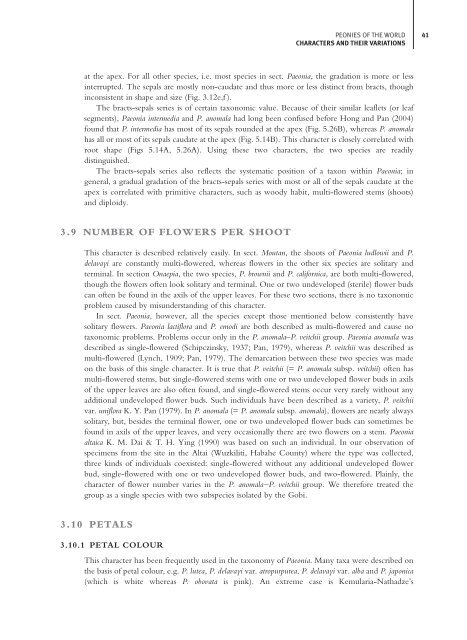Peonies of the World - Look inside - Royal Botanic Gardens, Kew
Peonies of the World - Look inside - Royal Botanic Gardens, Kew
Peonies of the World - Look inside - Royal Botanic Gardens, Kew
Create successful ePaper yourself
Turn your PDF publications into a flip-book with our unique Google optimized e-Paper software.
PEONIES OF THE WORLD<br />
CHARACTERS AND THEIR VARIATIONS<br />
41<br />
at <strong>the</strong> apex. For all o<strong>the</strong>r species, i.e. most species in sect. Paeonia, <strong>the</strong> gradation is more or less<br />
interrupted. The sepals are mostly non-caudate and thus more or less distinct from bracts, though<br />
inconsistent in shape and size (Fig. 3.12e,f ).<br />
The bracts-sepals series is <strong>of</strong> certain taxonomic value. Because <strong>of</strong> <strong>the</strong>ir similar leaflets (or leaf<br />
segments), Paeonia intermedia and P. anomala had long been confused before Hong and Pan (2004)<br />
found that P. intermedia has most <strong>of</strong> its sepals rounded at <strong>the</strong> apex (Fig. 5.26B), whereas P. anomala<br />
has all or most <strong>of</strong> its sepals caudate at <strong>the</strong> apex (Fig. 5.14B). This character is closely correlated with<br />
root shape (Figs 5.14A, 5.26A). Using <strong>the</strong>se two characters, <strong>the</strong> two species are readily<br />
distinguished.<br />
The bracts-sepals series also reflects <strong>the</strong> systematic position <strong>of</strong> a taxon within Paeonia; in<br />
general, a gradual gradation <strong>of</strong> <strong>the</strong> bracts-sepals series with most or all <strong>of</strong> <strong>the</strong> sepals caudate at <strong>the</strong><br />
apex is correlated with primitive characters, such as woody habit, multi-flowered stems (shoots)<br />
and diploidy.<br />
3.9 NUMBER OF FLOWERS PER SHOOT<br />
This character is described relatively easily. In sect. Moutan, <strong>the</strong> shoots <strong>of</strong> Paeonia ludlowii and P.<br />
delavayi are constantly multi-flowered, whereas flowers in <strong>the</strong> o<strong>the</strong>r six species are solitary and<br />
terminal. In section Onaepia, <strong>the</strong> two species, P. brownii and P. californica, are both multi-flowered,<br />
though <strong>the</strong> flowers <strong>of</strong>ten look solitary and terminal. One or two undeveloped (sterile) flower buds<br />
can <strong>of</strong>ten be found in <strong>the</strong> axils <strong>of</strong> <strong>the</strong> upper leaves. For <strong>the</strong>se two sections, <strong>the</strong>re is no taxonomic<br />
problem caused by misunderstanding <strong>of</strong> this character.<br />
In sect. Paeonia, however, all <strong>the</strong> species except those mentioned below consistently have<br />
solitary flowers. Paeonia lactiflora and P. emodi are both described as multi-flowered and cause no<br />
taxonomic problems. Problems occur only in <strong>the</strong> P. anomala–P. veitchii group. Paeonia anomala was<br />
described as single-flowered (Schipczinsky, 1937; Pan, 1979), whereas P. veitchii was described as<br />
multi-flowered (Lynch, 1909; Pan, 1979). The demarcation between <strong>the</strong>se two species was made<br />
on <strong>the</strong> basis <strong>of</strong> this single character. It is true that P. veitchii (= P. anomala subsp. veitchii) <strong>of</strong>ten has<br />
multi-flowered stems, but single-flowered stems with one or two undeveloped flower buds in axils<br />
<strong>of</strong> <strong>the</strong> upper leaves are also <strong>of</strong>ten found, and single-flowered stems occur very rarely without any<br />
additional undeveloped flower buds. Such individuals have been described as a variety, P. veitchii<br />
var. uniflora K. Y. Pan (1979). In P. anomala (= P. anomala subsp. anomala), flowers are nearly always<br />
solitary, but, besides <strong>the</strong> terminal flower, one or two undeveloped flower buds can sometimes be<br />
found in axils <strong>of</strong> <strong>the</strong> upper leaves, and very occasionally <strong>the</strong>re are two flowers on a stem. Paeonia<br />
altaica K. M. Dai & T. H. Ying (1990) was based on such an individual. In our observation <strong>of</strong><br />
specimens from <strong>the</strong> site in <strong>the</strong> Altai (Wuzkiliti, Habahe County) where <strong>the</strong> type was collected,<br />
three kinds <strong>of</strong> individuals coexisted: single-flowered without any additional undeveloped flower<br />
bud, single-flowered with one or two undeveloped flower buds, and two-flowered. Plainly, <strong>the</strong><br />
character <strong>of</strong> flower number varies in <strong>the</strong> P. anomala–P. veitchii group. We <strong>the</strong>refore treated <strong>the</strong><br />
group as a single species with two subspecies isolated by <strong>the</strong> Gobi.<br />
3.10 PETALS<br />
3.10.1 PETAL COLOUR<br />
This character has been frequently used in <strong>the</strong> taxonomy <strong>of</strong> Paeonia. Many taxa were described on<br />
<strong>the</strong> basis <strong>of</strong> petal colour, e.g. P. lutea, P. delavayi var. atropurpurea, P. delavayi var. alba and P. japonica<br />
(which is white whereas P. obovata is pink). An extreme case is Kemularia-Nathadze’s

















